Brut Rosé
Niederösterreich Sekt, Schloss Gobelsburg, 750 ml

| Grape variety: | Pinot noir, Zweigelt, Sankt Laurent |
| Producer: | Weingut Schloss Gobelsburg |
| Origin: | Austria / Niederösterreich |
Description
Welcome and spoil your guests with pink pearls from Austria! This hand- shaken sparkling wine is produced using traditional methods, and two to three years of bottle ageing on the lees contribute to its fine texture and noble character. The cuvée of Pinot Noir, Zweigelt and Sankt Laurent smells of cranberries and wild strawberries, spring herbs and is clothed in a slightly tart citrus note and floral hints. This sparkling wine is lean on the palate, but with a mouth-filling mousse and refreshing acidity as well as mineral grip. The aroma is characterised by an animating variety of citrus fruits and red berries.
Falstaff Sparkling Special 2022: 93 points

The winery Schloss Gobelsburg scored 93 points at the Falstaff Sparkling Special 2022 with the Sekt Rosé Brut NV.
Attributes
| Origin: | Austria / Niederösterreich |
| Grape variety: | Pinot noir, Zweigelt, Sankt Laurent |
| Label: | Vegan |
| Ripening potential: | 1 to 3 years |
| Drinking temperature: | 10 to 12 °C |
| Food Pairing: | Apéro riche, Cakes, biscuits, pastries, Hot vegetable curries, Hot Asian dishes, Moroccan specialities |
| Vinification: | pressing the whole grape, fermentation in steel tank |
| Harvest: | hand-picking, strict selection, in small boxes |
| Maturation: | in large wooden barrel/foudre, on the yeast |
| Maturation duration: | 36 months |
| Volume: | 11.5 % |
| Note: | Contains sulphites |
Pinot noir
Blueprint of the terroir
No other variety expresses its terroir as precisely as Pinot noir. It is a sensitive, fragile grape. But when it succeeds, it gives the world some of its very greatest wine plants. It especially excels in Burgundy, where it has been cultivated for at least 700 years. Even in the middle ages, it was considered so precious that it was kept separate from other grapes so as to not diminish its value. The finest examples are delicate and fragrant with aromas of cherries and red berries. With maturity, notes of forest floor, leather and truffles enter as well. An irresistible fruity sweetness still shines through, even after several decades. The Pinot noir does well in cool locations: in Switzerland and in Germany, where it is known as Blauburgunder and Spätburgunder respectively; in Alsace and in South Tyrol, in Oregon, New Zealand and Tasmania. Not least, it yields fantastic champagnes. It is a wonderful culinary companion. With its soft tannins and charming bouquet, it meshes with everything, from Güggeli and cheeses to fried fish.

Sankt Laurent
The grape with the halo
The berries of the Saint Laurent fade from the tenth of August, St. Lawrence’s day, the patron saint of chefs. In its homeland in Austria, the variety was formerly called Laurenzitraube. With its aroma of fresh sour cherries and elegant tannins, it appears to be a more powerful version of Pinot noir. However, the two are not related. The Saint Laurent is currently undergoing a boom. Its wines are deep-red, velvety, full-bodied and aromatic. Above all, the qualities from the oak barrels delight lovers of softer, fuller reds. Yet the largest cultivation area is not in Austria, but the Czech Republic. A little anecdote: the Saint Laurent lost its halo there during the Soviet era, and was allowed only to be called Vavrinecké instead of Svatovavrinecké.

Zweigelt
Flatterer with a backbone
The Zweigelt is an Austrian original. Fritz Zweigelt crossed it in 1922 at the Klosterneuberg Orchard and Viniculture School ("Obst- und Weinbauschule Klosterneuburg") from the red varieties Blaufränkisch and Saint Laurent. Zweigelt's main quality is being marvellously drinkable. With its exuberant berry fruit and juicy structure, it fits like no other to the pleasurable lifestyle of our Austrian neighbours. One thinks, for example, of a hearty Brettjause in the wine tavern. It can, however, also assemble well with other grape varieties, and expand in wooden barrels for more backbone. No wonder it is the most planted grape variety in Austria. One curiosity: the Japanese island of Hokkaido grows 230 hectares of Zweigelt.

Niederösterreich
Lower Austria: crus near and far from the Danube
Austria's largest state is also its largest wine region. 46,000 hectares are planted with vines in Lower Austria. It is a heterogenic wine region, consisting of eight wine growing areas. While white varieties like Grüner Veltliner and Riesling dominate in the areas north and west of Vienna, red varieties set the tone in the south and in the southeast (Thermenregion and Carnuntum). The internationally famous white crus from Grüner Veltliner and Riesling develop in the picturesque Wachau and Kamptal.

Austria
Austria – Sumptuous culture, accessible to all
Austria is characterized by unbelievable topographical diversity. A flat steppe in the east, forests and hills in the Alpine regions, wetlands and Mediterranean landscapes in the south. This in addition to a rich tradition and even greater love. It’s no surprise that the Romans found joy on this patch of Earth and cultivated wine growing. Austrian wine is not abundant, but it is high quality.



